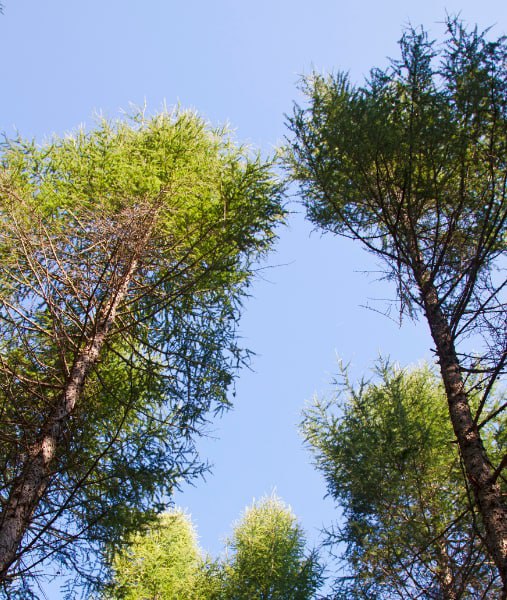Proper tree care is essential for maintaining the health, safety, and appearance of your trees. One of the key components of tree care is pruning, a practice that involves the selective removal of branches to enhance a tree’s structure and wellbeing. However, not all pruning is the same—there are different techniques used depending on the specific needs of the tree. At Rye Tree Surgeons, we specialise in all types of professional tree pruning in Rye, East Sussex, and we’re here to help you understand the three main types of pruning: crown lifting, crown thinning, and crown reduction.
1. Crown Lifting: Creating Space Below the Canopy
Crown lifting, also known as crown raising, is the process of removing the lower branches of a tree to increase the clearance between the ground and the canopy. This technique is particularly useful for trees that are planted near pathways, roads, or buildings, where low-hanging branches could pose a hazard or obstruct views.
- When to Consider Crown Lifting: Crown lifting is ideal when you need to allow more light to reach the area beneath the tree, such as gardens or lawns, or when you need to improve access for vehicles or pedestrians. It is often used to make trees look more open and visually balanced while keeping the canopy intact.
- Benefits of Crown Lifting: This technique can enhance the appearance of the tree by creating a more defined trunk and canopy, giving it a more elegant shape. It also improves safety by preventing branches from obstructing paths or roadways, making it a common choice for urban areas.
- Important Considerations: Crown lifting should be performed carefully, as removing too many lower branches can create an unbalanced structure and weaken the tree. At Rye Tree Surgeons, our team of professionals ensures that crown lifting is done with precision, maintaining the tree’s natural shape and health.
2. Crown Thinning: Improving Light and Airflow
Crown thinning involves the selective removal of branches throughout the entire canopy to reduce the density of the tree. Unlike crown lifting, which focuses on the lower branches, crown thinning is performed throughout the tree’s crown, reducing the weight of the branches and allowing more light and air to penetrate the canopy.
- When to Consider Crown Thinning: This technique is ideal for trees with dense foliage that casts heavy shade, as it allows more sunlight to reach the areas below. It’s also used to reduce the wind resistance of the tree, making it more stable during storms or strong winds. Thinning can be especially beneficial for trees with a tendency to develop dense, heavy crowns that could become top-heavy.
- Benefits of Crown Thinning: Crown thinning can improve the health of the tree by increasing airflow through the canopy, reducing the risk of disease and fungal growth. It also allows more light to reach the tree’s interior and surrounding plants, promoting a healthier, more balanced ecosystem in your garden.
- Important Considerations: Proper crown thinning requires a careful approach, as over-thinning can stress the tree and leave it vulnerable to pests and diseases. Our experts at Rye Tree Surgeons use professional techniques to ensure the tree retains its natural shape while achieving the desired level of thinning.
3. Crown Reduction: Controlling Size and Shape
Crown reduction is a technique used to decrease the overall size of a tree’s canopy. This involves shortening the branches evenly throughout the crown, reducing its height and spread without altering its natural shape. Crown reduction is particularly useful for managing the size of trees that have outgrown their space or are growing too close to structures or power lines.
- When to Consider Crown Reduction: This type of pruning is often used for large trees that are encroaching on nearby buildings or power lines, or when a tree poses a risk of damage to property due to its size. It can also be beneficial for trees that have suffered storm damage and need to be reshaped for better structural integrity.
- Benefits of Crown Reduction: Crown reduction can make a tree safer by reducing the risk of branches breaking or falling during adverse weather conditions. It also helps to maintain a balanced shape, making the tree more visually appealing while ensuring that it fits well within its environment.
- Important Considerations: Crown reduction should be done carefully to avoid leaving large wounds, which can make the tree susceptible to decay. At Rye Tree Surgeons, we ensure that crown reduction is performed using industry-standard methods, preserving the tree’s health and structure while achieving the desired size.
Conclusion
Understanding the different types of tree pruning—crown lifting, thinning, and reduction—can help you make informed decisions about how to maintain your trees. Each method serves a specific purpose, whether it’s improving clearance, enhancing light and airflow, or managing the overall size of a tree. At Rye Tree Surgeons, we are committed to providing expert pruning services that ensure the health, safety, and aesthetic appeal of your trees in Rye, East Sussex.
If you’re unsure which pruning technique is right for your trees, contact us today for a professional consultation. Our experienced team can assess your trees’ needs and recommend the best approach, ensuring that your garden remains beautiful, safe, and thriving all year round. Let us help you maintain the perfect balance between nature and your outdoor space with our expert tree care services.
Call us on: 01797 334499
Click here to find out more about Rye Tree Surgeons
Click here to complete our contact form and see how we can help with your tree’s needs.
